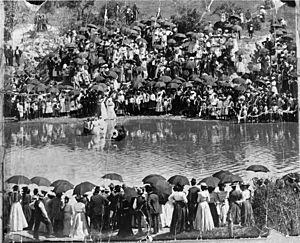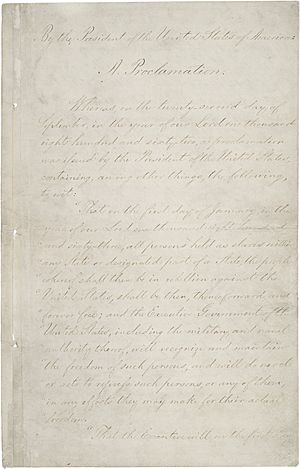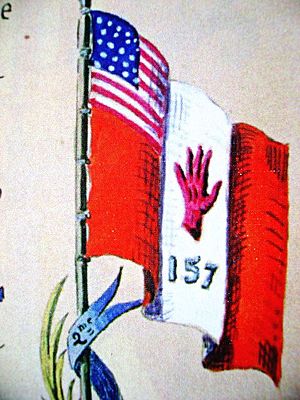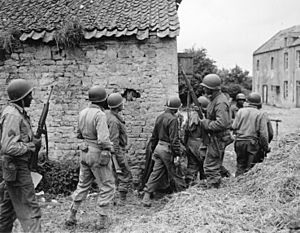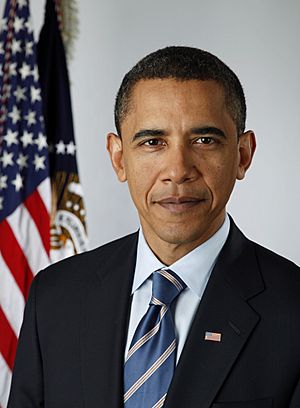African American history facts for kids
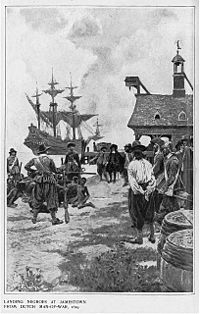
African-American history is the portion of American history that specifically discusses the African American or Black American ethnic group in the United States.
Most African Americans are the descendants of captive Africans held in the United States from 1619 to 1865. Blacks from the Caribbean whose ancestors immigrated, or who immigrated to the U.S., also traditionally have been considered African American, as they share a common history of predominantly West African or Central African roots, the Middle Passage and slavery.
It is these peoples, who in the past were referred to and self-identified collectively as the American Negro, who now generally consider themselves African Americans. Their history is celebrated and highlighted annually in the United States during February, designated as Black History Month, and it is their history that is the focus of this article.
Others who sometimes are referred to as African Americans, and who may self-identify as such in US government censuses, include relatively recent Black immigrants from Africa, South America and elsewhere who self-identify as being of African descent.
Contents
- African origins
- Introduction of slavery
- The Revolution and early America
- The Antebellum Period
- The American Civil War
- Emancipation and Reconstruction
- Jim Crow, disfranchisement and challenges
- Civil rights
- The Great Migration and the Harlem Renaissance
- World War I
- World War II
- Second Great Migration
- The Civil Rights Movement
- Post Civil Rights Era African-American history
- Images for kids
African origins
The majority of African Americans descend from enslaved people, most of whom were sold into slavery as prisoners of war by African states or kidnapped by African, Arab, European or American slave traders. The existing market for slaves in Africa was exploited and expanded by European powers in search of free labor for New World plantations.
The American slave population was made up of the various ethnic groups from western and central Africa, including the Bakongo, Igbo, Mandé, Wolof, Akan, Fon and Makua amongst others. Over time in most areas of the Americas, these different peoples did away with tribal differences and forged a new history and culture that was a creolization of their common pasts and present.
The regions from which Africans were sold or taken during the Atlantic slave trade were:
- Senegambia, encompassing the coast from the Senegal River to the Casamance River, where captives as far away as the Upper and Middle Niger River Valley were sold
- The Sierra Leone region included territory from the Casamance to the Assini River in the modern countries of Guinea-Bissau, Guinea, Sierra Leone, Liberia and Côte d'Ivoire
- The Gold Coast region consisted of mainly modern Ghana
- The Bight of Benin region stretched from the Volta River to the Benue River in modern Togo, Benin and southwestern Nigeria
- The Bight of Biafra extended from southeastern Nigeria through Cameroon into Gabon
- The region of Mozambique-Madagascar included the modern countries of Mozambique, parts of Tanzania and Madagascar.
Origins and Percentages of African Americans imported into British North America and Louisiana (1700–1820)
| Region | Percentage |
|---|---|
| West Central Africa | 26.1% |
| Bight of Biafra | 24.4% |
| Sierra Leone | 15.8% |
| Senegambia | 14.5% |
| Gold Coast | 13.1% |
| Bight of Benin | 4.3% |
| Mozambique-Madagascar | 1.8% |
Introduction of slavery
The first African slaves were brought to Jamestown, Virginia in 1619. The English settlers treated these captives as indentured servants and released them after a number of years. This practice was gradually replaced by the system of race-based slavery used in the Caribbean. As servants were freed, they became competition for resources. Additionally, released servants had to be replaced.
Massachusetts was the first colony to legalize slavery in 1641. Other colonies followed suit by passing laws that passed slavery on to the children of slaves and making non-Christian imported servants enslaved people for life.
Africans first arrived in 1619, when a Dutch ship sold 19 blacks as indentured servants (not slaves) to Englishmen at Point Comfort (today's Fort Monroe), thirty miles downstream from Jamestown, Virginia. In all, about 10-12 million Africans were transported to Western Hemisphere.
The vast majority of these people came from that stretch of the West African coast extending from present-day Senegal to Angola; a small percentage came from Madagascar and East Africa. Only 3% (about 300,000) went to the American colonies. The vast majority went to the West Indies, where they died quickly. Demographic conditions were highly favorable in the American colonies, with less disease, more food, some medical care, and lighter work loads than prevailed in the sugar fields.
At first the Africans in the South were outnumbered by white indentured servants, who came voluntarily from Britain. They avoided the plantations. With the vast amount of good land and the shortage of laborers, plantation owners turned to lifetime slaves who worked for their keep but were not paid wages and could not easily escape.
Generally the slaves developed their own family system, religion and customs in the slave quarters with little interference from owners, who were only interested in work outputs.
By 1700 there were 25,000 slaves in the American colonies, about 10% of the population. A few had come from Africa but most came from the West Indies (especially Trinidad, later Trinidad and Tobago), or, increasingly, were native born.
Their legal status was now clear: they were enslaved people for life and so were the children of slave mothers. They could be sold, or freed, and a few ran away.
Slowly a free black population emerged, concentrated in port cities along the Atlantic coast from Charleston to Boston. Slaves in the cities and towns had many more privileges, but the great majority of slaves lived on southern tobacco or rice plantations, usually in groups of 20 or more.
The most serious slave rebellion was the Stono Uprising, in September 1739 in South Carolina. The colony had about 56,000 slaves, who outnumbered whites 2:1. About 150 slaves rose up, and seizing guns and ammunition, murdered twenty whites, and headed for Spanish Florida. The local militia soon intercepted and killed most of them.
All the American colonies had slavery, but it was usually in the form of personal servants in the North (where 2% of the people were slaves), and field hands in plantations in the South (where 25% were slaves.)
The Revolution and early America
The later half of the 18th century was a time of political upheaval in the United States. In the midst of cries for relief from British rule, several people pointed out the apparent hypocrisies of slave holders' demanding freedom. The Declaration of Independence, a document that would become a manifesto for human rights and personal freedom, was written by Thomas Jefferson, who owned over 200 slaves. Other Southern statesmen were also major slaveholders. The Second Continental Congress did consider freeing slaves to disrupt British commerce. They removed language from the Declaration of Independence that included the promotion of slavery amongst the offenses of King George III. A number of free Blacks, most notably Prince Hall, the founder of Prince Hall Freemasonry, submitted petitions for the end of slavery. But these petitions were largely ignored.
This did not deter the Blacks, free and slave, from participating in the Revolution. Crispus Attucks, a free Black tradesman, was the first casualty of the Boston Massacre and of the ensuing American Revolutionary War. 5,000 Blacks, including Prince Hall, fought in the Continental Army. Many fought side by side with White soldiers at the battles of Lexington and Concord and at Bunker Hill. But when George Washington took command in 1775, he barred any further recruitment of Blacks.
By contrast, the British and Loyalists offered emancipation to any slave owned by a Patriot who was willing to join the Loyalist forces. Lord Dunmore, the Governor of Virginia, recruited 300 African American men into his Ethiopian regiment within a month of making this proclamation. In South Carolina 25,000 slaves, more than one-quarter of the total, escaped to join and fight with the British, or fled for freedom in the uproar of war. Thousands of slaves also escaped in Georgia and Virginia, as well as New England and New York. Well-known Black Loyalist soldiers include Colonel Tye and Boston King.
The Americans eventually won the war. In the provisional treaty, they demanded the return of property, including slaves. Nonetheless, the British helped up to 4,000 documented African Americans to leave the country for Nova Scotia, Jamaica, and Britain rather than be returned to slavery.
The Constitutional Convention of 1787 sought to define the foundation for the government of the newly formed United States of America. The constitution set forth the ideals of freedom and equality while providing for the continuation of the institution of slavery through the fugitive slave clause and the three-fifths compromise.
Additionally, free blacks' rights were also restricted in many places. Most were denied the right to vote and were excluded from public schools. Some Blacks sought to fight these contradictions in court. In 1780, Elizabeth Freeman and Quock Walker used language from the new Massachusetts constitution that declared all men were born free and equal in freedom suits to gain release from slavery. A free Black businessman in Boston named Paul Cuffe sought to be excused from paying taxes since he had no voting rights.
In the Northern states, the revolutionary spirit did help African Americans. Beginning in the 1750s, there was widespread sentiment during the American Revolution that slavery was a social evil (for the country as a whole and for the whites) that should eventually be abolished. All the Northern states passed emancipation acts between 1780 and 1804; most of these arranged for gradual emancipation and a special status for freedmen, so there were still a dozen "permanent apprentices" into the 19th century.
In 1787 Congress passed the Northwest Ordinance and barred slavery from the large Northwest Territory. In 1790, there were more than 59,000 free Blacks in the United States. By 1810, that number had risen to 186,446. Most of these were in the North, but Revolutionary sentiments also motivated Southern slaveholders.
For 20 years after the Revolution, more Southerners also freed slaves, sometimes by manumission or in wills to be accomplished after the slaveholder's death. In the Upper South, the percentage of free blacks rose from about 1% before the Revolution to more than 10% by 1810. Quakers and Moravians worked to persuade slaveholders to free families. In Virginia the number of free blacks increased from 10,000 in 1790 to nearly 30,000 in 1810, but 95% of blacks were still enslaved. In Delaware, three-quarters of all blacks were free by 1810. By 1860 just over 91% of Delaware's blacks were free, and 49.1% of those in Maryland.
Among the successful free men was Benjamin Banneker, a Maryland astronomer, mathematician, almanac author, surveyor and farmer, who in 1791 assisted in the initial survey of the boundaries of the future District of Columbia. Despite the challenges of living in the new country, most free Blacks fared far better than the nearly 800,000 enslaved Blacks. Even so, many considered emigrating to Africa.
The Antebellum Period
As the United States grew, the institution of slavery became more entrenched in the southern states, while northern states began to abolish it. Pennsylvania was the first, in 1780 passing an act for gradual abolition.
A number of events continued to shape views on slavery. The invention of the cotton gin in 1793 allowed the cultivation of short staple cotton, which could be grown in inland areas. This triggered a huge demand for imported slave labor to develop new cotton plantations. There was a 70% increase in the number of slaves in the United States in only 20 years, and they were overwhelmingly concentrated in the Deep South.
In 1808, Congress abolished the international slave trade. While American Blacks celebrated this as a victory in the fight against slavery, the ban increased the demand for slaves. Changing agricultural practices in the Upper South from tobacco to mixed farming decreased labor requirements, and slaves were sold to traders for the developing Deep South. In addition, the Fugitive Slave Act of 1793 allowed any Black person to be claimed as a runaway unless a White person testified on their behalf. A number of free Blacks, especially indentured children, were kidnapped and sold into slavery with little or no hope of rescue. By 1819 there were exactly 11 free and 11 slave states, which increased sectionalism. Fears of an imbalance in Congress led to the 1820 Missouri Compromise that required states to be admitted to the union in pairs, one slave and one free.
Over 1 million slaves were moved from the older seaboard slave states, with their declining economies to the rich cotton states of the southwest; many others were sold and moved locally.
The Black community
The number of free Blacks grew during this time as well. By 1830 there were 319,000 free Blacks in the United States. 150,000 lived in the northern states. While the majority of free blacks lived in poverty, some were able to establish successful businesses that catered to the Black community.
Racial discrimination often meant that Blacks were not welcome or would be mistreated in White businesses and other establishments. To counter this, Blacks developed their own communities with Black-owned businesses. Black doctors, lawyers and other businessmen were the foundation of the Black middle class.
Blacks organized to help strengthen the Black community and continue the fight against slavery. One of these organizations was the American Society of Free Persons of Colour, founded in 1830. These organizations provided social aid to poor blacks and organized responses to political issues. The Black community also established schools for Black children, since they were often barred from entering public schools. Further supporting the growth of the Black Community was the Black church. Starting in the early 1790s with the African Methodist Episcopal Church, African Methodist Episcopal Zion Church and other churches, the Black church grew to be the focal point of the Black community. The Black church was both an expression of community and unique African-American spirituality, and a reaction to European American discrimination. At first, Black preachers formed separate congregations within the existing denominations. Because of discrimination at the higher levels of the church hierarchy, some blacks simply founded separate Black denominations.
Free blacks also established Black churches in the South before 1800. After the Great Awakening, many blacks joined the Baptist Church, which allowed for their participation, including roles as elders and preachers. Petersburg, an industrial city, by 1860 had 3,224 free blacks, the largest population in the South. In Virginia, free blacks also created communities in Richmond, Virginia and other towns, where they could work as artisans and create businesses. Others were able to buy land and farm in frontier areas further from white control.
The American Civil War
Emancipation and Reconstruction
In 1863, during the American Civil War (1861–1865), President Abraham Lincoln issued the Emancipation Proclamation, freeing slaves in the southern states at war with the North. The 13th amendment of the U.S. Constitution, ratified in 1865, outlawed slavery in the United States. In 1868, the 14th amendment granted full U.S. citizenship to African-Americans. The 15th amendment, ratified in 1870, extended the right to vote to black males.
After the Union victory over the Confederacy, a brief period of southern black progress, called Reconstruction, followed. From 1865 to 1877, under protection of Union troops, some strides were made toward equal rights for African-Americans. Southern black men began to vote and were elected to the United States Congress and to local offices such as sheriff. Coalitions of white and black Republicans passed bills to establish the first public school systems in most states of the South, although sufficient funding was hard to find. Blacks established their own churches, towns and businesses. Tens of thousands migrated to Mississippi for the chance to clear and own their own land, as 90% of the bottomlands were undeveloped. By the end of the century, two-thirds of the farmers who owned land in the Mississippi Delta bottomlands were black.
The aftermath of the Civil War accelerated the process of national African-American identity formation. Tens of thousands of Black northerners left homes and careers and also migrated to the defeated South, building schools, printing newspapers, and opening businesses.
Jim Crow, disfranchisement and challenges
The Jim Crow laws were state and local laws in the United States enacted between 1876 and 1965. They mandated segregation in all public facilities, with a supposedly "separate but equal" status for black Americans. In reality, this led to treatment and accommodations that were usually inferior to those provided for white Americans, creating a number of economic, educational and social disadvantages.
In the face of years of mounting violence and intimidation directed at blacks as well as whites sympathetic to their cause, the U.S. government retreated from its pledge to guarantee constitutional protections to freedmen and women. When President Rutherford B. Hayes withdrew Union troops from the South in 1877 as a result of a national compromise on the election, white Democratic southerners acted quickly to reverse the groundbreaking advances of Reconstruction. To reduce black voting and regain control of state legislatures, Democrats had used a combination of violence, fraud, and intimidation since the election of 1868. These techniques were prominent among paramilitary groups such as the White League and Red Shirts in Louisiana, Mississippi, and Florida prior to the 1876 elections. In South Carolina, for instance, one historian estimated that 150 blacks were killed in the weeks before the election. Massacres occurred at Hamburg and Ellenton.
White paramilitary violence against African Americans intensified. Many blacks were fearful of this trend, and men like Benjamin "Pap" Singleton began speaking of separating from the South. This idea culminated in the 1879-1880 movement of the Exodusters, who migrated to Kansas.
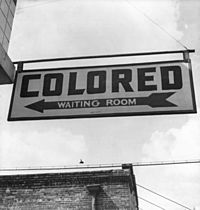
White Democrats first passed laws to make voter registration and elections more complicated. Most of the rules acted overwhelmingly against blacks, but many poor whites were also disfranchised. Voting by blacks in rural areas and small towns dropped sharply, as did voting by poor whites.
From 1890 to 1908, starting with Mississippi and ending with Georgia, ten of eleven Southern states adopted new constitutions or amendments that effectively disfranchised most blacks and many poor whites. Using a combination of provisions such as poll taxes, residency requirements and literacy tests, states dramatically decreased black voter registration and turnout, in some cases to zero.
Seeking to return blacks to their subordinate status under slavery, white supremacists resurrected barriers and enacted new laws to segregate society along racial lines. They limited black access to transportation, schools, restaurants and other public facilities. White supremacists also promoted the idea that blacks' participation in government in the South was ended due to incompetence; this view was disseminated in school textbooks and movies such as The Birth of a Nation in 1915. Although slavery had been abolished, most southern blacks for decades continued to struggle in grinding poverty as agricultural, domestic and menial laborers. Many became sharecroppers, their economic status little changed by emancipation.
Racial terrorism
After its founding in 1867, the Ku Klux Klan, a secret vigilante organization sworn to perpetuate white supremacy, became a power for a few years in the South and beyond, eventually establishing a northern headquarters in Greenfield, Indiana. Its members hid behind masks and robes to hide their identity while they carried out violence and property damage. The Klan employed killings and other forms of terrorism, physical violence, house burnings, and intimidation. The Klan's excesses led to the passage of legislation against it, and with Federal enforcement, it was squeezed out by 1871.
The Jim Crow era accompanied the most cruel wave of "racial" suppression that America has yet experienced. Between 1890 and 1940, millions of African Americans were disfranchised, killed, and brutalized.
Of the tens of thousands of murderers and onlookers during this period, it is reported that fewer than 50 whites were ever indicted for their crimes, and only four sentenced.
Most blacks were denied their right to keep and bear arms under Jim Crow laws, and they were therefore unable to protect themselves or their families.
Civil rights
In response to these and other setbacks, in the summer of 1905, W. E. B. Du Bois and 28 other prominent, African-American men met secretly at Niagara Falls, Ontario. There, they produced a manifesto calling for an end to racial discrimination, full civil liberties for African Americans and recognition of human brotherhood. The organization they established came to be called the Niagara Movement. During this period, African Americans continued to create independent community and institutional lives for themselves. They established schools, churches, social welfare institutions, banks, newspapers and small businesses to serve the needs of their communities.
The Great Migration and the Harlem Renaissance
During the first half of the 20th century, the largest internal population shift in U.S. history took place. Starting about 1910, through the Great Migration over five million African Americans made choices and "voted with their feet" by moving from the South to northern cities, the West and Midwest in hopes of escaping political discrimination and hatred, violence, finding better jobs, voting and enjoying greater equality and education for their children. In the 1920s, the concentration of blacks in New York led to the cultural movement known as the Harlem Renaissance, whose influence reached nationwide. Black intellectual and cultural circles were influenced by thinkers such as Aimé Césaire and Léopold Sédar Senghor, who celebrated blackness, or négritude; and arts and letters flourished. Writers Zora Neale Hurston, Langston Hughes, Nella Larsen, Claude McKay and Richard Wright; and artists Lois Mailou Jones, William H. Johnson, Romare Bearden, Jacob Lawrence and Archibald Motley gained prominence.
The South Side of Chicago, a destination for many on the trains up from Mississippi, Arkansas and Louisiana, became the black capital of America, generating flourishing businesses, music, arts and foods. A new generation of powerful African American political leaders and organizations also came to the fore.
World War I
The U.S. armed forces remained segregated during World War I. Still, many African Americans eagerly volunteered to join the Allied cause following America's entry into the war. More than two million African American men rushed to register for the draft. By the time of the armistice with Germany in November 1918, over 350,000 African Americans had served with the American Expeditionary Force in on the Western Front.
Most African American units were relegated to support roles and did not see combat. Still, African Americans played a minor role in America's war effort.
Four African American regiments were integrated into French units because the French suffered heavy losses and badly needed men after three years of a terrible war.
One of the most distinguished units was the 369th Infantry Regiment, known as the "Harlem Hellfighters", which was on the front lines for six months, longer than any other American unit in the war. 171 members of the 369th were awarded the Legion of Merit.
The 371st and 372nd African American Regiments were integrated under the 157th Red Hand Division commanded by the French General Mariano Goybet. They earned glory in the decisive final offensive in Champagne region of France. The two Regiments were decorated by the French Croix de Guerre for their gallantry in the Meuse-Argonne Offensive .
Corporal Freddie Stowers of the 371st Infantry Regiment was posthumously awarded a Medal of honor—the only African American to be so honored for actions in World War I. During action in France, Stowers had led an assault on German trenches, continuing to lead and encourage his men even after being wounded twice. Stowers died from his wounds, but his men continued the fight on a German machine gun nest near Bussy farm in Champagne, and eventually defeated the German troops.
Stowers was recommended for the Medal of Honor shortly after his death, but according to the Army, the nomination was misplaced. Many believed the recommendation had been intentionally ignored due to institutional racism in the Armed Forces. In 1990, under pressure from Congress, the Defense Department launched an investigation. Based on findings from this investigation, the Army Decorations Board approved the award of the Medal of Honor to Stowers. On April 24, 1991–73 years after he was killed in action—Stowers' two surviving sisters received the Medal of Honor from President George H.W. Bush at the White House.
World War II
Military
Over 1.5 million blacks served in uniform during World War II. They served in segregated units.
Famous segregated units, such as the Tuskegee Airmen and the U.S. 761st Tank Battalion proved their value in combat. Approximately 75 percent of the soldiers who served in the European theater as truckers for the Red Ball Express and kept Allied supply lines open were African American. A total of 708 African Americans were killed in combat during World War II.
The distinguished service of these units was a factor in President Harry S. Truman's order to end discrimination in the Armed Forces in July 1948, with the promulgation of Executive Order 9981. This led in turn to the integration of the Air Force and the other services by the early 1950s.
Civilian
Large numbers migrated from poor Southern farms to munitions centers. Racial tensions were high in overcrowded cities like Chicago; Detroit and Harlem experienced race riots in 1943. Politically they left the Republican Party and joined the Democratic New Deal Coalition of President Franklin D. Roosevelt, whom they widely admired.
The political leaders, ministers and newspaper editors who shaped opinion resolved on a Double V Campaign: Victory over German and Japanese fascism abroad, and victory over discrimination at home. Black newspapers created the Double V Campaign to build black morale and head off radical action.
Most Black women had been farm laborers or domestics before the war. Despite discrimination and segregated facilities throughout the South, they escaped the cotton patch and took blue-collar jobs in the cities.
Second Great Migration
The Second Great Migration was the migration of more than 5 million African Americans from the South to the other three regions of the United States. It took place place from 1941, through World War II, and lasted until 1970. It was much larger and of a different character than the first Great Migration (1910–1940). Some historians prefer to distinguish between the movements for those reasons.
In the Second Great Migration, more than five million African Americans moved to cities in states in the North, Midwest and West, including many to California, where Los Angeles and Oakland offered many skilled jobs in the defense industry. More of these migrants were already urban laborers who came from the cities of the South. They were better educated and had better skills than people who did not migrate.
Compared to the more rural migrants of the period 1910-1940, many African Americans in the South were already living in urban areas and had urban job skills before they relocated. They moved to take jobs in the burgeoning industrial cities and especially the many jobs in the defense industry during World War II (WWII). Workers who were limited to segregated, low-skilled jobs in Southern cities were able to get highly skilled, well-paid jobs at California shipyards.
By the end of the Second Great Migration, African Americans had become an urbanized population. More than 80 percent lived in cities. Fifty-three percent remained in the Southern United States, while 40 percent lived in the Northeast and North Central states and 7 percent in the West.
The Civil Rights Movement
The Supreme Court handed down a landmark decision in the case of Brown v. Board of Education (1954) of Topeka. This decision led to the dismantling of legal segregation in all areas of southern life, from schools to restaurants to public restrooms, but it occurred slowly and only after concerted activism by African Americans.

Perhaps the high point of the Civil Rights Movement was the 1963 March on Washington for Jobs and Freedom, which brought more than 250,000 marchers to the grounds of the Lincoln Memorial and the National Mall in Washington, D.C., to speak out for an end to southern racial violence and police brutality, equal opportunity in employment, equal access in education and public accommodations. The organizers of the march were the "Big Seven" of the Civil Rights Movement: Bayard Rustin the strategist who has been called the "invisible man" of the civil rights movement; labor organizer and initiator of the march, A. Phillip Randolph; Roy Wilkins of the NAACP; Whitney Young, Jr., of the National Urban League; Martin Luther King, Jr., of the Southern Christian Leadership Conference (SCLC); James Farmer of the Congress on Racial Equality (CORE); and John Lewis of the Student Non-violent Coordinating Committee (SNCC). Also active behind the scenes and sharing the podium with Dr. King was Dorothy Height, head of the National Council of Negro Women. It was at this event, on the steps of the Lincoln Memorial, that King delivered his historic "I Have a Dream" speech. This march and the conditions which brought it into being are credited with putting pressure on President John F. Kennedy and then Lyndon B. Johnson that culminated in the passage the Civil Rights Act of 1964 that banned discrimination in public accommodations, employment, and labor unions.
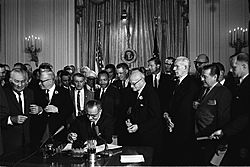
The "Mississippi Freedom Summer" of 1964 brought thousands of idealistic youth, black and white, to the state to run "freedom schools", to teach basic literacy, history and civics.
From the mid-1960s to the mid-1970s, the Black Power movement urged African Americans to look to Africa for inspiration and emphasized black solidarity, rather than integration.
Post Civil Rights Era African-American history
Politically and economically, blacks have made substantial strides in the post-civil rights era. Civil rights leader Jesse Jackson, who ran for the Democratic Party's presidential nomination in 1984 and 1988, brought unprecedented support and leverage to blacks in politics.
In 1989, Douglas Wilder became the first African-American elected governor in U.S. history. In 1992 Carol Moseley-Braun of Illinois became the first black woman elected to the U.S. Senate. There were 8,936 black officeholders in the United States in 2000, showing a net increase of 7,467 since 1970. In 2001 there were 484 black mayors.
The 38 African-American members of Congress form the Congressional Black Caucus, which serves as a political bloc for issues relating to African Americans. The appointment of blacks to high federal offices—including General Colin Powell, Chairman of the U.S. Armed Forces Joint Chiefs of Staff, 1989–1993, United States Secretary of State, 2001–2005; Condoleezza Rice, Assistant to the President for National Security Affairs, 2001–2004, Secretary of State in, 2005–2009; Ron Brown, United States Secretary of Commerce, 1993–1996; and Supreme Court justices Thurgood Marshall and Clarence Thomas—also demonstrates the increasing visibility of blacks in the political arena.
Economic progress for blacks' reaching the extremes of wealth has been slow. According to Forbes richest lists, Oprah Winfrey was the richest African American of the 20th century and has been the world's only black billionaire in 2004, 2005, and 2006. Not only was Winfrey the world's only black billionaire but she has been the only black on the Forbes 400 list nearly every year since 1995. BET founder Bob Johnson briefly joined her on the list from 2001-2003 before his ex-wife acquired part of his fortune; although he returned to the list in 2006, he did not make it in 2007. With Winfrey the only African American wealthy enough to rank among America's 400 richest people, blacks currently comprise 0.25% of America's economic elite and comprise 13% of the U.S. population.
In 2008, Illinois senator Barack Obama became the first black presidential nominee of the Democratic Party, making him the first African-American presidential candidate from a major political party. He was elected as the 44th President of the United States on November 4, 2008, and inaugurated on January 20, 2009.
Images for kids
-
A plantation in Louisiana.
-
Eight Tuskegee Airmen in front of a P-40 fighter aircraft
-
First and Second Great Migrations shown through changes in African American share of population in major U.S. cities, 1916–1930 and 1940–1970




